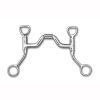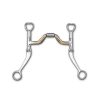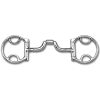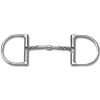Myler Bit System

The Myler brothers developed the Myler bitting system to allow for more effective communication between the horse and rider, thus improving the horse’s ability to learn and raising their level of performance. The single most important part of a horse is its mindset and what many inexperienced riders don’t take into account is the fact that the bit they use directly impacts upon the way in which the horse thinks and behaves.
The Problem With Traditional Bits
Many traditional bits aren’t designed in a way that minimizes stress effectively and the rider will often experience resistance from their horse or their commands may be evaded altogether. This is because many of these bits have been designed around the belief that horses evade and resist bar pressure more than anything else and their design, which often collapses completely and pushes down into the tongue (in addition to pinching the outer lips and bar), creates a great deal of tension.
The Myler brothers firmly believe (their theory has been backed up by extensive research and the opinions of several medical practitioners) that in actual fact it’s excessive tongue pressure, rather than bar pressure, that causes a horse to become evasive. Horses, just like humans, need to be able to move their tongues in order to swallow. If you restrict the horse’s ability to swallow, not only will this unsettle the horse mentally (impacting upon its ability to focus), but you will also impair the horse physically. The tongue is the strongest muscle in a horse’s entire body and it’s connected to the hyoid bone, as well as the shoulders of the horse. If the tongue is completely restricted, it can’t fully utilize key muscle groups in these areas and is unable to lift its back. Not only that, but when excess tongue pressure is applied, the tongue often gets pushed back up into the throat and restricts the flow of air, which naturally affects performance.
In addition to the negative mental and physical effects that arise due to the design of traditional bitting systems, the signals that are produced by these bits aren’t particularly clear either. For example, with the single jointed bit that we’ve already mentioned, when the rider wants to pick the horse’s shoulder up, when he lifts either right or left, the bit will pull in that direction but at the same time it will also drive down into the tongue. This produces somewhat of a mixed signal and can confuse the horse.
How the Myler System Addresses These Issues
The Myler bitting system incorporates a number of innovative features to ensure that any factors (such as the ones mentioned above) that could cause interference in communication between horse and rider are removed. Some of these features include:
- U-Shaped Collapse – When bits collapse into a V shape, excess pressure is placed on the tongue and the bars and outer lips are pinched too. Myler bits collapse into a U shape instead, ensuring no pinching takes place and the bit doesn’t drive down into the tongue.
- Curved Design – Bits that go straight across the mouth allow little room for the tongue, making swallowing very difficult and they apply more direct pressure onto the lips and bars. Myler bits feature a curved design, naturally allowing more space for the tongue.
- Optimal Thickness – An overly thick bit won’t sit comfortably in the horse’s mouth and may cause both discomfort and resistance. Based upon years of testing, the majority of Myler bits are 7/16″ thick (equivalent to 11.11mm), which ensures a comfortable fit for virtually any horse’s mouth. Should your horse’s mouth be extremely irregular in terms of size or shape, completely customized bits are available.
- Metals Used – The bits found in the western style Myler range, the combination range and the cradle range are produced using a sweet iron that has a copper inlay. When this oxidizes (this will occur when it comes into contact with the moisture present in the horse’s mouth), it produces a sweet taste that horses enjoy and encourages a relaxed mindset. The pieces in the English style range are produced from stainless steel with a copper inlay.
- Independent Side Movement (ISM) – This is a feature that many Myler bits possess and it ensures that the horse is always given a very clear and precise signal. You will see a barrel in the middle of the mouthpiece which functions as a bushing and makes it possible for each side of the bit to function entirely separately from each other. This ensures that when the rider wants to lift one of the horse’s shoulders, only one side of the bit is raised and the horse knows exactly what you’re asking it to do.
- Hooks – The cheekpieces used on Myler bits have been adapted to include a feature they call “hooks.” These hooks are essentially slots that ensure the bridle is kept in place, while creating an additional rein position. By attaching the reins to the hook rather than directly to the ring, the rider can lift the cheek and engage the Independent Side Movement (ISM) feature without applying any additional pressure on the horse’s mouth.






